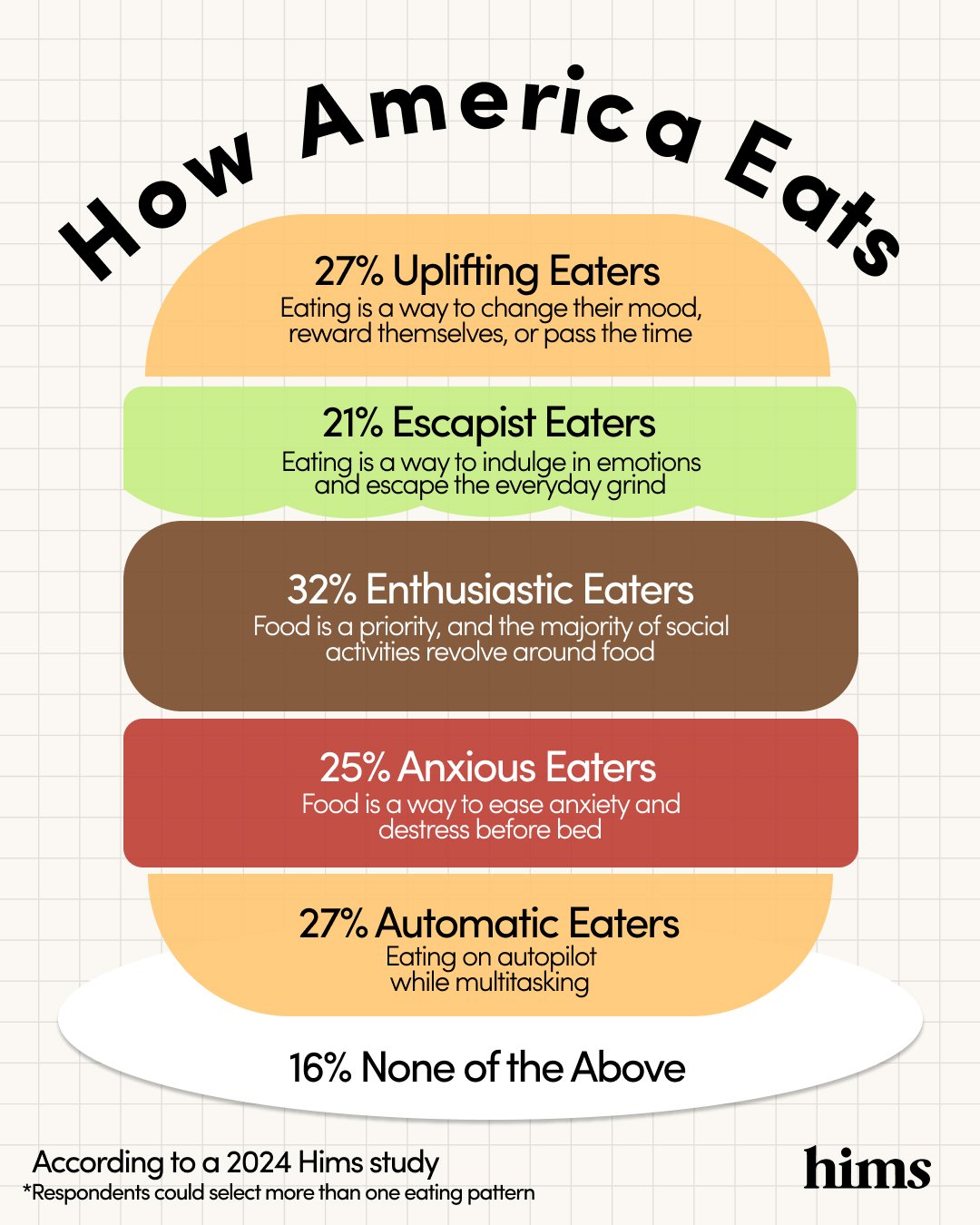Wind: mph,
Welcome to our new web site!
To give our readers a chance to experience all that our new website has to offer, we have made all content freely avaiable, through October 1, 2018.
During this time, print and digital subscribers will not need to log in to view our stories or e-editions.

Where you live may influence your eating and health habits more than you think.
Do you savor every meal or squeeze in a sandwich during your commute? Are you more likely to indulge in comfort foods while watching your favorite show or try new foods dining out with friends? Personality plays a part, but a 2024 Hims study shows regionality may also play a significant role in eating behavior.
Hims compares America's most anxious, automatic, enthusiastic, escapist, and uplifting foodie capitals.
There's more to weight loss than just diet and exercise. While nutrition and movement play a large role, there's also a behavioral component to holistic weight loss. A team of psychologists and weight loss experts at Hims have identified five eating patterns that typically describe people's primary eating habits: anxious, automatic, enthusiastic, escapist, and uplifting.
Hims asked people which eating pattern best describes their primary eating habits (selecting all that apply) and looked at trends in major cities across the country to determine if where they live impacts their eating habits. 84% of Americans fit into one of five eating patterns. Here's how the country stacks up.

The Big Easy is known for its world-renowned foodie culture. So it's no wonder that New Orleans tops the list of America's most Enthusiastic Eaters, with nearly half (45%) of New Orleanians reporting that the majority of their social activities revolve around food, compared to 32% of Americans overall.
So, what's the recipe for their enthusiasm? First, they are quite a bit more social than the rest of America. 66% of residents of New Orleans describe themselves as "extroverted" as compared to just 31% of the nationally representative population. Prioritizing food in one's social life is a key part of being an Enthusiastic Eater.
Second, they're experimental. 60% of New Orleans residents identify as such compared to 39% of the U.S. population. Likely, they are open to—and enthusiastic about—trying new cuisine.
Lastly, they are more likely than almost any city in the country to self-identify as "multicultural." Two-thirds (66%) say they cross multiple races, ethnicities, or cultures, as compared to 30% of Americans overall. The variety of cultures in their own backyard no doubt makes them enthusiastic to "culture sample" through food.
Percent who identify as Enthusiastic Eaters
44% of Atlanta residents describe themselves as "Automatic Eaters" who multitask and tend to eat on autopilot. This compares to just 27% of the country who says they do the same.
Atlanta is also the top city to report that they are worried about their weight, with 33% of residents saying it tops their list of stressors vs. 25% of Americans overall.
Distracted or "mindless" eating can be a key contributor to consuming more calories than needed to nourish your body. When you eat on autopilot, it's very easy to underestimate the volume of food you consume in a day.
Percent who identify as Automatic Eaters
San Antonio, Texas residents are one-third more likely than other top cities to say they are "Uplifting Eaters" using food to improve their mood when they're feeling down (39% vs. 27%, respectively).
While eating to get out of a funk is common—as mentioned, 27% of Americans identify with this eating pattern most, making it the number two eating pattern after Enthusiastic Eaters—what Hims found in its research is that San Antonio needs some self-love.
San Antonio residents report feeling less emotionally stable than Americans overall (51% vs. 59%, respectively).
Percent who identify as Uplifting Eaters
Statistically speaking, Salt Lake City residents are stressed out. 61% of Salt Lake City residents rate themselves as a 4 or 5 on being "stressed" as compared to just 37% of Americans overall.
They're also the most likely in the country to say they turn to food when they're stressed out, anxious, or can't sleep: 38% identified as Anxious Eaters vs. 25% of total respondents.
Percent who identify as Anxious Eaters
Residents of Minnesota's biggest metropolitan hub—Minneapolis-St. Paul—were the most likely to classify themselves as "Escapist Eaters" who use food to escape certain emotions (31% vs. 21% of respondents overall).
Minneapolis also ranked #1 in emotional stability, with 74% of Minneapolis and St. Paul residents saying they were highly emotionally stable (a 5 on a 5-point scale) or emotionally stable (a 4 on a 5-point scale) as compared to just 59% of Americans overall. And 78% report being "happy" vs. 66% of the rest of the country.
Percent who identify as Escapist Eaters
This study is based on a 5,504-person online survey, which included 5,000 18-to-65-year-old respondents in the top 50 metropolitan areas (100 respondents per city) and a nationally representative sample of 504 18-to-65-year-old respondents to contextualize results. The study was fielded in May 2024.
Hims asked respondents, "Which of the following best describe your primary eating habits?" and asked them to select all that apply. Findings were analyzed by more than 100 demographic and psychographic cuts, including city, region, gender (when Hims refers to "women" and "men," this includes all people who self-identify as such), age, race and ethnicity, relationship status, parenting status, sexual orientation (heterosexual, bisexual, gay, lesbian, pansexual, asexual, queer, etc.), and political affiliation, among other areas of interest.
All data in this study are from this source, unless otherwise noted. Independent research firm, Culture Co-op, conducted and analyzed research and findings. Get the data.
This story was produced by Hims and reviewed and distributed by Stacker Media.